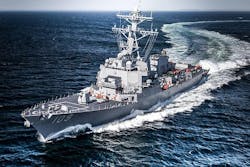Lockheed Martin to install Navy shipboard undersea warfare systems in potential $169.5 million contract
Officials of the Naval Sea Systems Command in Washington are asking the Lockheed Martin Missiles and Fire Control segment in Orlando, Fla., for SQQ-89 undersea warfare product supportability and installation efforts. The contract has options that could increase its value to $169.5 million.
The AN/SQQ-89A(V)15 is a surface ship undersea warfare combat system designed to search, detect, classify, localize, and track undersea contacts like submarines, unmanned underwater vehicles (UUVs), and submerged mines. This contract combines purchases for the U.S. Navy and government of Japan.
The system uses active and passive sonar to help commanders of Navy Arleigh Burke-class destroyers and Ticonderoga-class cruisers to attack or avoid enemy submarines; unmanned underwater vehicles (UUVs); floating, tethered, or bottom-attacked mines; and torpedoes.
Related: Navy asks Progeny Systems to upgrade decision-support system for submarine warfare
The AN/SQQ-89A(V)15 provides multi-sensor track correlation and target track management control, and forwards data to the ship’s weapons and decision-support systems. The AN/SQQ-89A(V)15 works together with the ship's active and passive hull-mounted sonar, multi-function towed array, sonobuoy processing, torpedo alerts, fire-control system, sensor performance predictions, embedded operator, and team training systems.
The system has an open electronics architecture to accommodate system upgrades, and makes the most of data accessibility and system modules, Lockheed Martin officials say. Its software application programs are isolated from hardware with open middleware to render applications processor-independent.
The system uses POSIX-compliant system calls and Motif and X-compliant display service calls. Symmetric multi-processors (SMPs) using Linux-based processing handle signal, data, display, and interface processing.
Recent and planned upgrades to the AN/SQQ-89A(V)15 include improved automated torpedo detection, sonar performance prediction, advanced active sonar processing, re-designed active displays to reduce operator loading, and integrated training and logistics.
Related: Navy underwater warfare experts choose legacy memory PMC cards from GE for torpedo research
The AN/SQQ-89 is integrated with the Aegis combat system, as well as the vertical launch anti-submarine rocket (ASROC) system. A variant of the AN/SQQ-89A(V)15 is integrated with late-version Aegis combat systems being installed onboard new Arleigh Burke-class destroyers. A back-fit program is in place to retrofit existing Burke-class ships and Ticonderoga-class cruisers.
On this contract modification Lockheed Martin will do the work in Norfolk, Va.; San Diego; Yososuka, Japan; Bath, Maine; Pascagoula, Miss.; Pearl Harbor, Hawaii; Everett, Wash.; Mayport, Fla.; and Rota, Spain, and should be finished by June 2017.
For more information contact Lockheed Martin MS2 online at www.lockheedmartin.com/us/mfc, or Naval Sea Systems Command at www.navsea.navy.mil.
